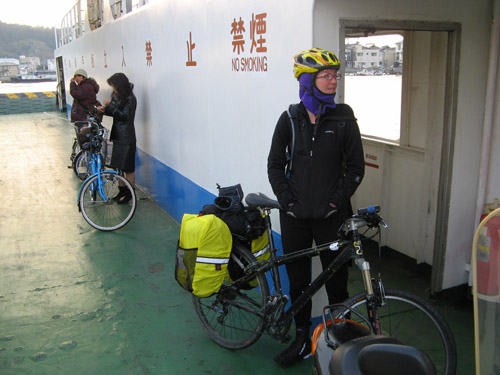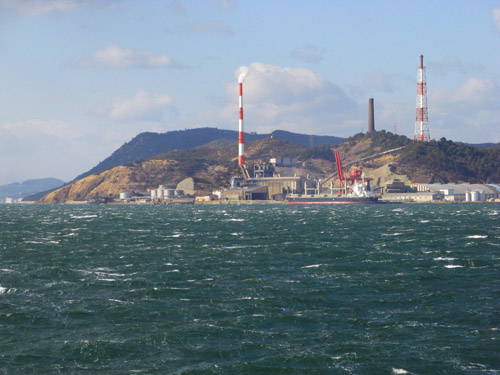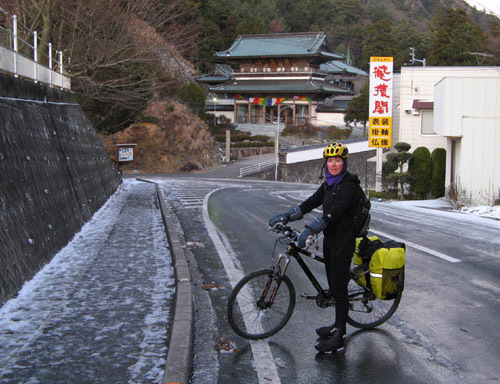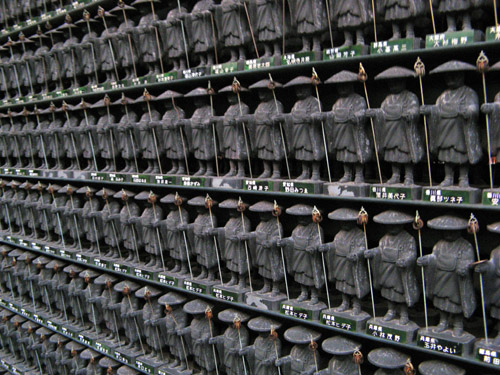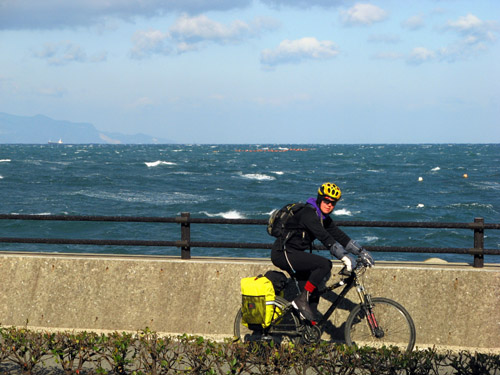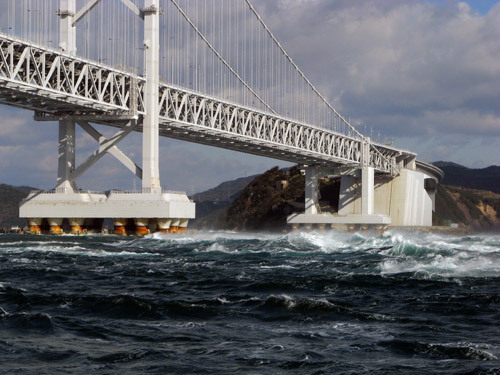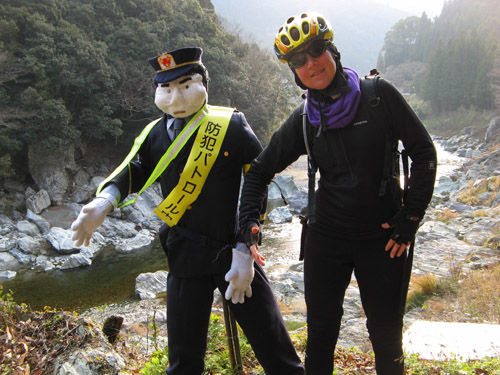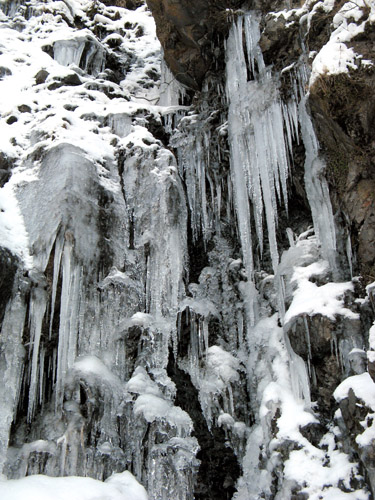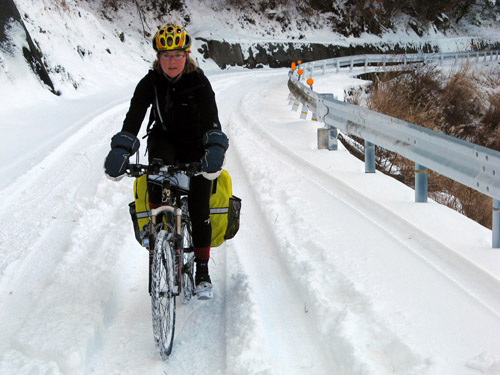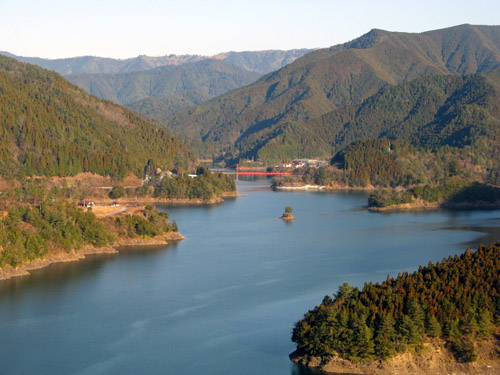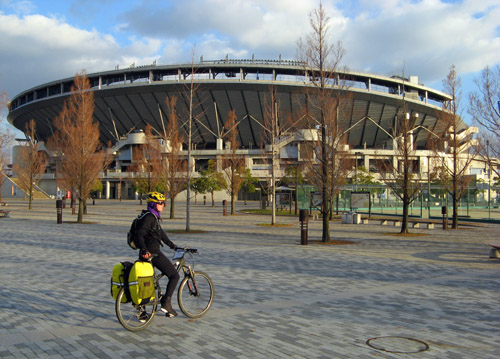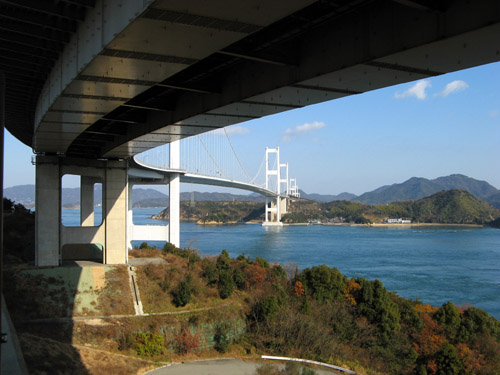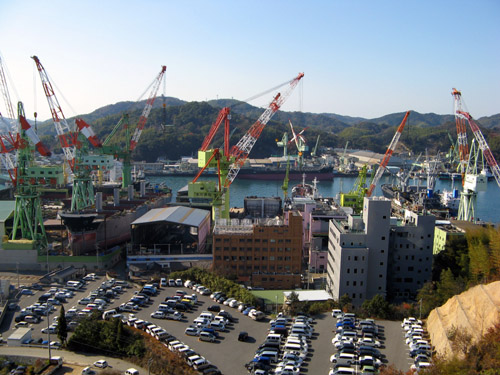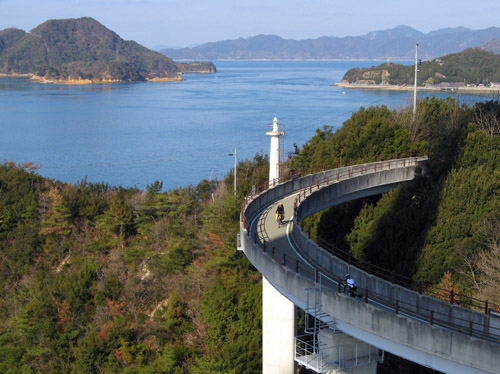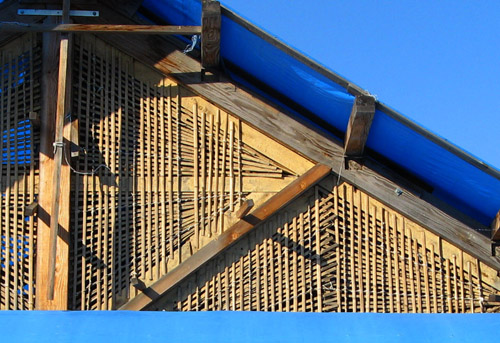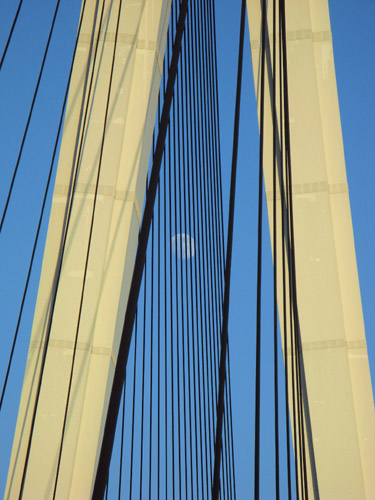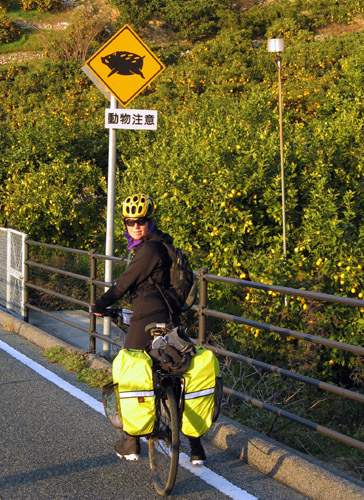Shikoku Tour Part III 四国ツアーその3「南国」
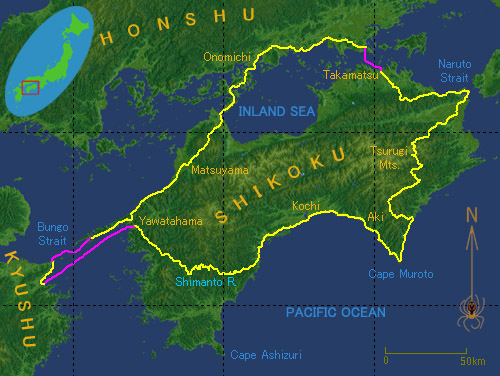
A map of our Shikoku cycling trip. The cycle route is shown in yellow and ferry sections are in magenta. We cycled some 1100km in 12 days.
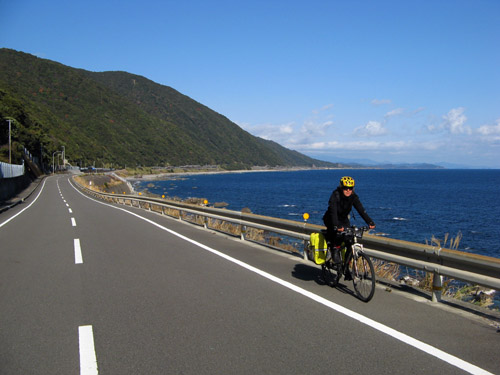
After a heady descent from the mountains, we suddenly find ourselves on the wide but nearly empty coastal highway heading to Cape Muroto, a pointed promontory that defines the south-east coast of the island. The warm Kuroshio Current impinges on Muroto like no other part of the Japanese mainland, influencing the local climate. It is significantly warmer than the inland areas, and subtropical vegetation such as palms abound on this coastline. As we did in the mountains, we have some trouble finding nourishment along this surprisingly barren stretch of road. It's mid-afternoon by the time we dig into our first meal of the day.
山から下りてきて、四国の南東に位置する室戸岬に向かって広い道路を走ります。海岸沿いに黒潮の影響を感じる。内陸より温暖な気候に恵まれたのでヤシの木等、亜熱帯植物が多く、周りは緑にあふれている。ここも店もなく、食べ物はなかなか手に入らず、昼下がりにやっと店を発見して、腹ごしらえをしました。

Overlooking the numerous tourist traps scattered around Muroto, we take a stroll in the rock gardens along the apex of the legendary cape. It is one of the stormiest and windiest places in Japan, but today the sea is calm as a mirror and there is almost no wind. Only the wave-swept gravel and pointed rocks scubbed bare by the ocean bear witness to the usual conditions.
伝説的な室戸岬でロックガーデンをぶらぶら歩く。いつも嵐が多く風の強い海岸は、今日、風もなく鏡のように凪海だった。
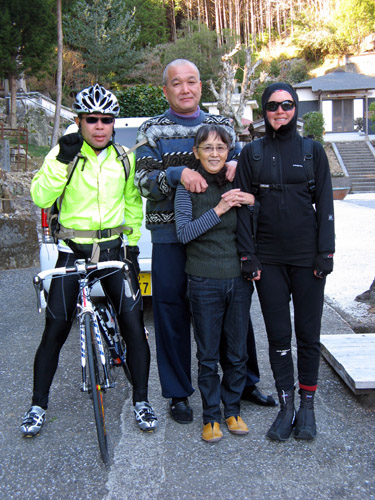
Muroto is a turning point of sorts on our journey: from here we head more or less back west, shrinking the distance to our destination point daily.
In the small city of Aki along the way, we meet Mr. Ito, his family and friends. He is a Buddhist priest. Leanne teaches English at a kindergarten in Amakusa that is adjunct to a temple, where she must be in the head priest's good books, because he gave her contact information for this disciple of his in Shikoku. We only intended to stop for tea, but upon a cordial invitation to stay, we decide to spend the night. We spend the afternoon and evening talking to Mr. Ito and his wife, who are first-rate hosts and warm, kind human beings. Then Mr. Ito takes us out for delicious Italian dinner, inviting two other interesting friends, including Hama-san (here on left), an erstwhile policeman and cyclist. He accompanied us half-way on our way the following day, glad for a reason to take his fancy road bike for a spin.
室戸から西へ向かう、旅の後半に入る。天草で里杏は週に一回お寺の管理している保育園で英語を教えている。そこで園長先生のお坊さんが四国にいる弟子の紹介をしてくれて、時間があればお寺を訪問すると決めた。それで、室戸の近くの安芸市で伊藤お坊さんのお寺に着いて、伊藤さんと家族が心から温かく歓迎してくれました。お寺でちょっと休憩してから、また走る予定だったが、『お寺で泊まれば』と招待されました。天気が晴れている日で休んだらちょっと不便になるが、伊藤さんたちは余りにも感じの良い人だったので結局泊らせて貰う事にしました。午後から夜中まで伊藤さん夫婦と沢山の話をしました。夕方になると美味しいイタリア料理の店に連れてもらって、盛り沢山のピザ、スパゲティ、カツオのたたき等、お腹一杯食べました。そこで伊藤さんの友達と知り合って、盛り上がりました。写真の左側の濱さんは元々大阪で警察官をしていましたが、現在は坂本竜馬の大ファンで四国に移り住みました。濱さんはスポーツが得意で翌日僕たちとロードバイクで走りました。人生では何よりも出会いが大切でしょう。
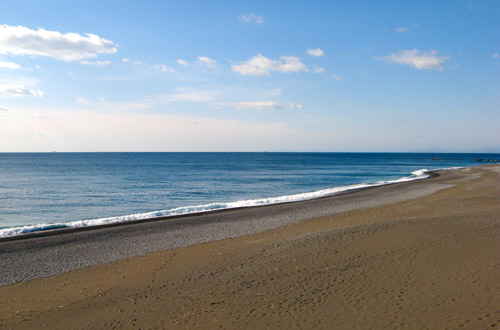
A cold but pleasant sunny day awaited us as we made our way along the great arc of Pacific beach on the Kochi coast in the south of Shikoku. The ocean stretched to the horizon on our left, framed by the distant Capes Muroto and Ashizuri; this grand scenery remained ever static, giving the illusion of cycling on a treadmill.
濱ちゃんと一緒に高知県の美しい海岸沿いの自転車専用ロードにポカポカ陽気の好天を楽しむ。広い太平洋は遠景の両側に室戸岬と足摺岬が絵を額に入れているように見える。この壮大な景色はいくら漕いでも変わらない、トレッドミルでサイクリングしているように感じる。
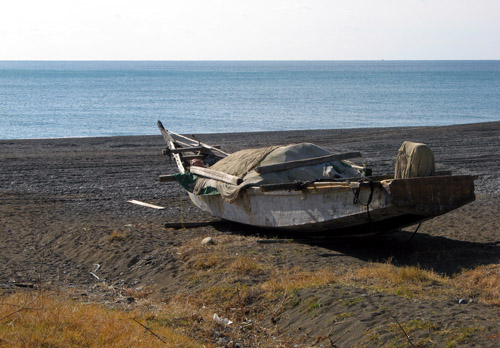
Traditional boats dotted the beach here and there, giving some perspective to the vast landscape. The absence of ports for long stretches here meant that fishing boats had to be designed to be beached when not in use.
広大な砂浜に伝統的な漁船は点在している。この辺りは、港が少ないので小船は浜に引き上げられ易く作られています。
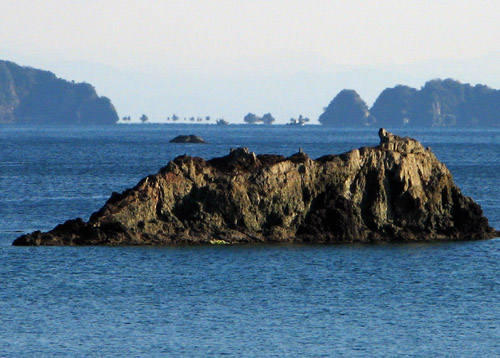
Taking advantage of the sea's warmth, we camped at the point where we would turn inland. The next morning's cold air created mirages as it met the warm sea among the rocks and islands of the coast.
内陸に入る前に暖かい海沿いでキャンプする。早朝の冷たい空気が暖かい海と打つかって逃げ水の現象が見えます。

We were unprepared for the dramatic transition to inland climate. Atop a 300 meter hill, we took a break in the sunshine still facing the ocean, enjoying what was probably the warmest outdoor moment of the whole tour. Then crossing a short tunnel to the plateau on the other side, we suddenly felt like we entered Siberia. A cold, biting wind hindered our progress and the water standing on the rice paddies became a sheet of ice. The wind and cold continued as we entered the valley of the scenic Shimanto River, where icicles hung from the ubiquitous water wheels at roadside tourist traps. Resting at a bank of jidohanbaiki, Leanne comforts herself with a can of hot drink while she checks the map wondering how much more headwind we'll have to endure.
暖かい海岸から300mの坂を登ってトンネルを取り抜けると内陸の方はシベリアの気候のように水田は凍結していて、身を刺すような風が吹いていた。四万十川の谷に入るとひやりとした向かい風が吹き続け、観光地の水車から氷柱が垂れ下がっていた。自動販売機で「後どのぐらいこの逆風に立ち向かわないといけないか」と暖かい飲料を飲みながらしょげた顔の里杏は地図を見る。

Even as we struggled on we were not oblivious to the quaint scenery of the Shimanto. This clear-running river is well known as one of the only un-dammed and generally undisturbed rivers in the country, so much so that it may be the only attraction in Shikoku Japanese know about. Here, Leanne crosses a typical one-lane, guardrail-less bridge across the pristine-looking water.
大規模なダムが建設されていない四万十川は日本三大清流の一つと呼ばれている。新鮮な川の上に里杏はガードレールなしの狭い橋を渡ります。
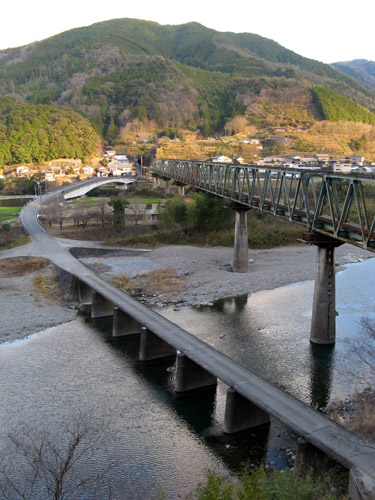
Here's another view of one of these bridges. A railroad also snakes along the river valley. Rail tours of the Shimanto are undoubtedly popular in season with Japan's multitude of train enthusiasts.
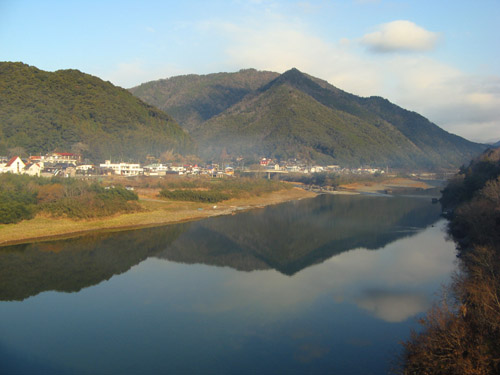
The end of a long day brought us to the town of Ekawasaki on the lower stretches on the river, where we soaked our tired bodies in a hot spring and even enjoyed a coin operated massage chair. These facilities were built for tourists, but winter is off season and we had them to ourselves. Similarly, we installed our tent on a comfortable wooden deck at the riverside campground, free of charge as usual.
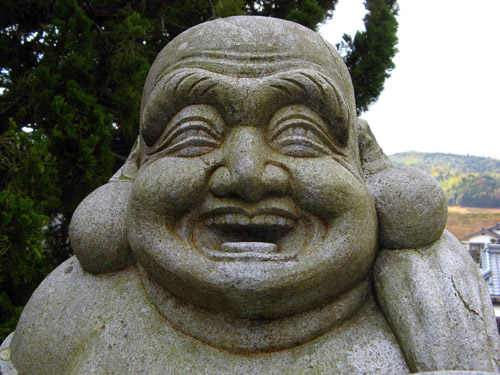
The weather, which had held wonderfully until now, began to destabilize somewhat, so from the Shimanto we made a one day run back to our car. We were once more on the track of the o-henro; this happy Buddha sits at one of the pilgrimage temples on the way. Beyond a final mountain pass awaited us, and then we descended once more to the ocean.
ここから天気は下り坂なので、四万十川から一日で車まで戻ろ為に頑張った。道沿いお寺の巡りをしていたお遍路さんをこの仏像が歓迎します。最後の峠を越えるとまた海の方へ下ります。

Construction machinery and hillsides covered with mandarin orange groves dominate the scenery at the port town of Yawatahama, from where the ferry would take us to Kyushu and our parked car. On the ferry and the drive home, we reflected on this trip. It has taken us through many landscapes, some beautiful, some dreary, and we had to patiently endure the cold, day after day. Perhaps the trip's greatest value was its subtle meditative quality; the endurance required strenghtening our spirirs, and reawakening in us an appreciation of the beauty of southwest Japan during its relatively mild but persistent winter season.
八幡浜港から九州行きのフェリーに乗ります。活気のある港町でミカン畑と工事が主な印象。
フェリーに乗り車で天草まで戻りながら四国の旅を振り返ます。常に寒い天気さを耐えながら美しい景色もわびしい景色も自転車から見ました。穏やかな精神状態になってきたのは多分旅の一番価値のある事。その状態で四国の本当の良さが分かって来ました。
Labels: shikoku bike tour 四国自転車ツアー

